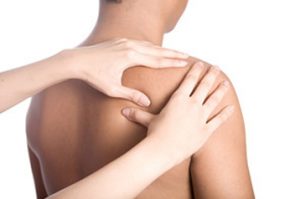 There are many causes of shoulder pain. Rotator cuff muscles which play a major role in shoulder function and preventing pain in and around the shoulder joint. The rotator cuff is a group of tendons – the supraspinatus, infraspinatus, subscapularis, and teres minor – that stabilize the shoulder joint and allow you to raise and rotate your arm.
There are many causes of shoulder pain. Rotator cuff muscles which play a major role in shoulder function and preventing pain in and around the shoulder joint. The rotator cuff is a group of tendons – the supraspinatus, infraspinatus, subscapularis, and teres minor – that stabilize the shoulder joint and allow you to raise and rotate your arm.
An inability to use these shoulder muscles and symptoms of pain, stiffness, and general weakness in the shoulder is called rotator cuff syndrome. It may be uncomfortable or impossible to do everyday activities, such as combing your hair, tucking in your shirt or reaching above your head. Most often, you will feel the pain on the front and side of your shoulder and upper arm. You may have pain during the night and experience trouble sleeping on the affected side.
The amount of pain varies, although it often increases when you raise your arm above the shoulder. The pain usually is closely related to the degree of damage/inflammation.
- Minor damage: Pain most often occurs only when you are active, especially while making overhead movements, and is usually relieved with rest.
- Moderate damage: You will likely notice pain both during and after activity; it may also occur at night, especially when lying on your shoulder.
- Severe damage: Continuous pain.
Most often, rotator cuff syndrome develops gradually, from aging, continued overuse, repetitive overhead activity or a combination of these factors.
One of the main reasons that the pain increases when you raise your arm above your head is that the upper tendon in the rotator cuff (supraspinatus tendon) and the subacromial bursa, which lies on top, glide between the underside of the top of your shoulder blade (acromion), and the gleno humeral head (upper end of your arm).
In a normal situation, the balance between friction and joint mobility allows for enough room for this tendon and bursa to move and function. But this mechanism will be significantly disturbed when there is not enough room for these structures to do their work and an impingement with a subsequent painful inflammation of the bursa (bursitis) and/or the tendon (tendonitis) will result every time you try to raise your arm.
The major reason for this impingement to happen is muscle imbalance between the rotator cuff and the deltoid muscle due to which the rotator cuff [mainly the supraspinatus muscle] can no longer balance and regulate the upward pull of the deltoid muscle [shoulder] on the gleno humeral head [head of the upper arm bone].
Over time, the tendon may wear against the undersurface of the acromion, causing tiny tears and bleeding. As those tears heal, the original healthy tissue is replaced by scar tissue that is weak, thickened, less flexible, and stringy (fibrous). The gradual scarring of the tendon causes the entire rotator cuff to weaken. The weaker the tendon becomes, the more susceptible it is to partial or complete tears, which happens more in the elderly population.
Without treatment, a simple muscle imbalance can cause a cycle of inflammation, tearing of tendons, and scar formation, resulting in pain and loss of function.
- Anti-inflammatory medications
- Steroid (cortisone) injections
- Surgery (last resort)
- Physical therapy
The therapists at ARC use physical therapy, manual techniques, soft tissue massage and modalities such as ultrasound, heat and medical acupuncture to loosen up the muscle tissue in order to increase the blood flow to the injured area, starting the healing process by providing access to nutrition and oxygen to the injured area. The focus of the treatment would be to retrain the muscles and redirect the glenohumeral joint so that shoulder impingement and inflammation will be relieved.
Conditions Treated
-
- Bursitis
- Carpal Tunnel Syndrome
- Chronic Fatigue Syndrome
- Circulation
- Fibromyalgia
- Foot & Heel Pain
- Frozen Shoulder
- Herniated Disk
- Lower Back Pain
- Lumbar Spinal Stenosis
- Migraines
- Neck Pain
- Osteoarthritis
- Peripheral Neuropathology
- Piriformis Syndrome
- Poor Posture
- Rheumatoid Arthritis
- Rotator Cuff
- Sciatica
- Shingles
- Sinusitis
- Tennis Elbow
- TMJ